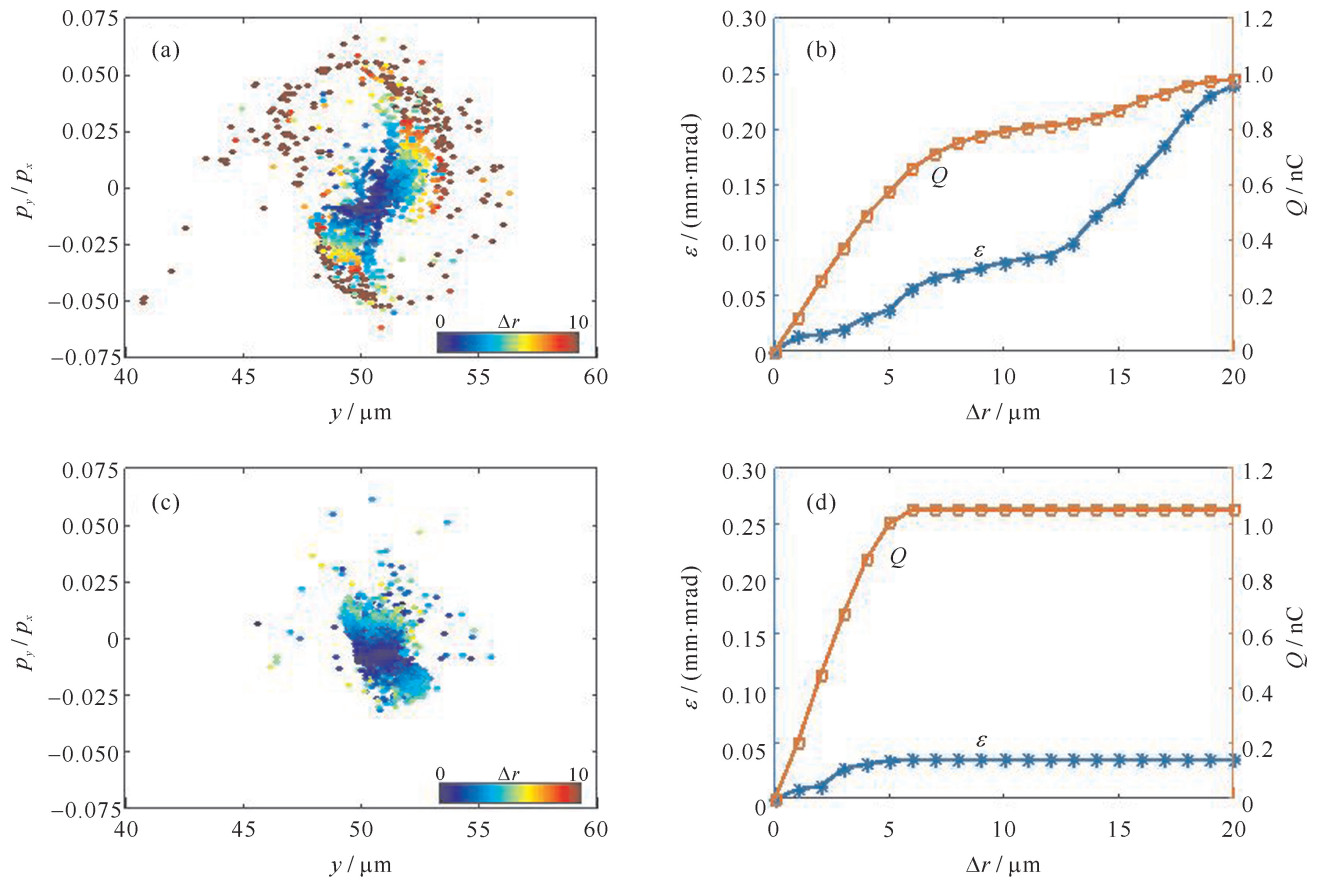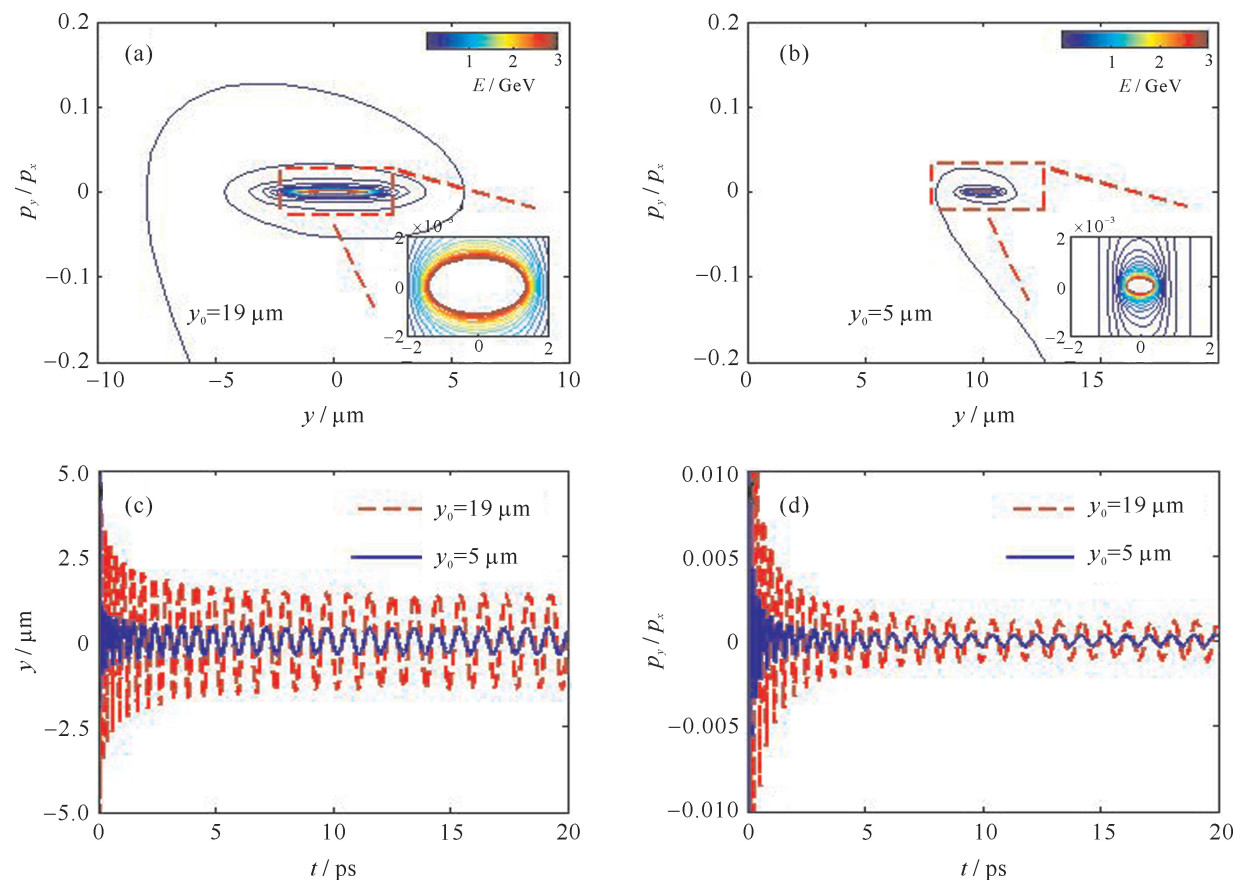Generation of high-quality electron beams based on tightly focused super-Gaussian laser
-
摘要: 在激光尾场加速中,光学注入是一种有效的可控电子注入机制。然而,低电量、大发散度的电子束特性无法满足实际应用的需要。为获得大电量、高品质电子束提出采用紧聚焦的超高斯激光作为注入脉冲的新型注入方案。研究发现,相比于普通高斯激光,紧聚焦的超高斯激光不仅能够将电子束发散度降低近一个数量级,而且能够保持电子束电荷量不变。通过哈密顿理论模型证实,离轴电子是发散度的主要来源,而紧聚焦的超高斯激光极大地限制了离轴电子的注入,因此有效地降低了电子束的发散度。Abstract: Electron optical injection is an efficient all-optical injection scheme in laser wakefield accelerations. However, low-charge and large emittance electron beam is still not suitable for many practical applications. This paper presents a novel injection scheme by colliding a tightly focused super-Gaussian laser with a Gaussian pump laser. It is found that the emittance of electron beam becomes almost an order of magnitude lower than that of all-Gaussian case, while the charge of electron bunch is conserved. It is also found that the electron emittance is mainly attributed to off-axis injected electrons by a Hamiltonian model. This unique ability will pave the way towards the generation of high-quality electron beams and extend the applications of laser-plasma accelerators.
-
图 1 (a) 高斯型注入脉冲下的注入电子横向相空间分布。不同颜色代表注入电子初始横向位置与主激光光轴的距离Δr。(b)相应的电子束发散度和电荷量与离轴距离Δr的关系。作为对比,采用紧聚焦超高斯激光作为注入脉冲时捕获电子的相空间分布及电子束发散度随离轴距离Δr的变化如(c)和(d)所示
Figure 1. (a)transverse phase-space distribution of trapped electrons in Gaussian case. Noted that colors represent Δr. (b)the beam emittance and total charge versus Δr. As a reference, the results by adopting a tightly focused super-Gaussian laser as the injection pulse are shown in (c) and (d)
图 3 不同初始横向位置的电子横向相空间动力学特性。(a)和(b)初始横向位置分别为y0=19 μm和y0=5 μm的电子的横向相空间轨迹。其中不同颜色代表不同的电子能量。(c)和(d)描述不同初始位置的电子的betatron振幅及发散角随时间的演化
Figure 3. (Color online). Transverse phase-space dynamics for electrons with different initial transverse position. (a) and (b) show transverse phase-space trajectories for two electrons with y0=19 μm and y0=5 μm respectively. The color represents the electron energy and the inset is the partial enlarged drawing. (c) and (d) show the evolution of the betatron amplitude y and the divergence py/px
-
[1] Esarey E, Schroeder C B, Leemans W P. Physics of laser-driven plasma-based electron accelerators[J]. Reviews of Modern Physics, 2009, 81: 1229-1285. doi: 10.1103/RevModPhys.81.1229 [2] Leemans W P, Nagler B, Gonsalves A J, et al. GeV electron beams from a centimetre-scale accelerator[J]. Nature Physics, 2006, 2(10): 696-699. doi: 10.1038/nphys418 [3] Hafz N A M, Jeong T M, Choi I W, et al. Stable generation of GeV-class electron beams from self-guided laser-plasma channels[J]. Nature Photonics, 2011, 2(9): 571-577. [4] Clayton C E, Ralph J E, Albert F, et al. Self-guided laser wakefield acceleration beyond 1 GeV using ionization-induced injection[J]. Physical Review Letters, 2010, 105: 105003. doi: 10.1103/PhysRevLett.105.105003 [5] Kim H T, Pae K H, Cha H J, et al. Enhancement of electron energy to the multi-GeV regime by a dual-stage laser-wakefield accelerator pumped by petawatt laser pulses[J]. Physical Review Letters, 2013, 111: 165002. doi: 10.1103/PhysRevLett.111.165002 [6] Wang X M, Zgadzaj R, Fazel N, et al. Quasi-monoenergetic laser-plasma acceleration of electrons to 2 GeV[J]. Nature Communications, 2013, 4(3): 131-140. [7] Leemans W P, Gonsalves A J, Mao H S, et al. Multi-GeV electron beams from capillary-discharge-guided subpetawatt laser pulses in the self-trapping regime[J]. Physical Review Letters, 2014, 113: 245002. doi: 10.1103/PhysRevLett.113.245002 [8] Yang L, Deng Z, Zhou C T, et al. High-charge energetic electron bunch generated by intersecting laser pulses[J]. Physics of Plasmas, 2013, 20: 033102. doi: 10.1063/1.4794352 [9] Kalmykov S Y, Beck A, Yi S A, et al. Electron self-injection into an evolving plasma bubble: Quasi-monoenergetic laser-plasma acceleration in the blowout regime[J]. Physics of Plasmas, 2011, 18(5): R6189. [10] Shen B, Wu Y, Dong K, et al. High-charge energetic electron bunch generated by 100 TW laser pulse[J]. Physics of Plasmas, 2012, 19: 033106. doi: 10.1063/1.3694679 [11] Németh K, Shen B, Li Y, et al. Laser-driven coherent betatron oscillation in a laser-wakefield cavity[J]. Physical Review Letters, 2008, 100: 095002. doi: 10.1103/PhysRevLett.100.095002 [12] Fuchs M, Weingartner R, Popp A, et al. Laser-driven soft-X-ray undulator source[J]. Nature Physics, 2009, 5(11): 826-829. doi: 10.1038/nphys1404 [13] Corde S, Phuoc K T, Fitour R, et al. Controlled betatron X-ray radiation from tunable optically injected electrons[J]. Physical Review Letters, 2011, 107: 255003. doi: 10.1103/PhysRevLett.107.255003 [14] Yan W, Chen L, Li D, et al. Concurrence of monoenergetic electron beams and bright X-rays from an evolving laser-plasma bubble[J]. Proc Natl Acad Sci USA, 2014, 111(16): 5825-5830. doi: 10.1073/pnas.1404336111 [15] Chen M, Esarey E, Schroeder C B, et al. Theory of ionization-induced trapping in laser-plasma accelerators[J]. Physics of Plasmas, 2012, 19: 033101. doi: 10.1063/1.3689922 [16] Yu L, Esarey E, Schroeder C B, et al. Two-color laser-ionization injection[J]. Physical Review Letters, 2014, 112: 125001. doi: 10.1103/PhysRevLett.112.125001 [17] SSchmid K, Buck A, Sears C M S, et al. Density-transition based electron injector for laser driven wakefield accelerators[J]. Physical Review Special Topics—Accelerators and Beams, 2010, 13: 091301. doi: 10.1103/PhysRevSTAB.13.091301 [18] Buck A, Wenz J, Xu J, et al. Shock-front injector for high-quality laser-plasma acceleration[J]. Physical Review Letters, 2013, 110(18): 185006. doi: 10.1103/PhysRevLett.110.185006 [19] Umstadter D, Kim J K, Dodd E. Laser injection of ultrashort electron pulses into wakefield plasma waves[J]. Physical Review Letters, 1996, 76(12): 2073-2076. doi: 10.1103/PhysRevLett.76.2073 [20] Esarey E, Hubbard R F, Leemans W P, et al. Electron injection into plasma wake fields by colliding laser pulses[J]. Physical Review Letters, 1997, 79(14): 2682-2685. doi: 10.1103/PhysRevLett.79.2682 [21] Schroeder C B, Lee P B, Wurtele J S, et al. Generation of ultra-short electron bunches by colliding laser pulses[J]. Physical Review E, 1999, 59: 6037-6047. doi: 10.1103/PhysRevE.59.6037 [22] Kotaki H, Masuda S, Kando M, et al. Head-on injection of a high quality electron beam by the interaction of two laser pulses[J]. Physics of Plasmas, 2004, 11(9): 4539-4539. doi: 10.1063/1.1775802 [23] Fubiani G, Esarey E, Schroeder C B, et al. Beat wave injection of electrons into plasma waves using two interfering laser pulses[J]. Physical Review E, 2004, 70: 016402. doi: 10.1103/PhysRevE.70.016402 [24] Sheng Z M, Mima K, Zhang J, et al. Efficient acceleration of electrons with counterpropagating intense laser pulses in vacuum and underdense plasma[J]. Physical Review E, 2004, 69: 016407. doi: 10.1103/PhysRevE.69.016407 [25] Faure J, Rechatin C, Norlin A, et al. Controlled injection and acceleration of electrons in plasma wakefields by colliding laser pulses[J]. Nature, 2006, 444(7120): 737-739. doi: 10.1038/nature05393 [26] Rechatin C, Faure J, Lifschitz A, et al. Quasi-monoenergetic electron beams produced by colliding cross-polarized laser pulses in underdense plasmas[J]. New Journal of Physics, 2009, 11: 013011. doi: 10.1088/1367-2630/11/1/013011 [27] Davoine X, Lefebvre E, Rechatin C, et al. Cold optical injection producing monoenergetic, multi-GeV electron bunches[J]. Physical Review Letters, 2009, 102: 065001. doi: 10.1103/PhysRevLett.102.065001 [28] Beck A, Davoine X, Lefebvre E. Scaling laws for electron cold injection in the narrow collision pulse approximation[J]. New Journal of Physics, 2011, 13(9): 093016. doi: 10.1088/1367-2630/13/9/093016 [29] Wang W M, Sheng Z M. Effect of laser parameters on electron injection into laser wakefields in plasma with a counterpropagating additional laser pulse[J]. Physics of Plasmas, 2008, 15: 13101. doi: 10.1063/1.2825671 [30] Rechatin C, Faure J, Ben-Ismail A, et al. Controlling the phase-space volume of injected electrons in a laser-plasma accelerator[J]. Physical Review Letters, 2009, 102: 164801. doi: 10.1103/PhysRevLett.102.164801 [31] Deng Z G, Yang L, Zhou C T, et al. Dual effects of stochastic heating on electron injection in laser wakefield acceleration[J]. Physics of Plasmas, 2014, 21: 083103. doi: 10.1063/1.4892262 [32] Lehe R, Lifschitz A F, Davoine X, et al. Optical transverse injection in laser-plasma acceleration[J]. Physical Review Letters, 2013, 111: 085005. doi: 10.1103/PhysRevLett.111.085005 [33] Cormier-Michel E, Ranjbar V, Bruhwiler D, et al. Design principles for high quality electron beams via colliding pulses in laser plasma accelerators[J]. Physical Review Special Topics—Accelerators and Beams, 2014, 17: 091301. doi: 10.1103/PhysRevSTAB.17.091301 [34] Deng Z G, Zhang Z M, Zhang B, et al. Large-charge quasimonoenergetic electron beams produced by off-axis colliding laser pulses in underdense plasma[J]. Physical Review E, 2017, 95(2/1): 023206. [35] Rechatin C, Faure J, Lifschitz A, et al. Plasma wake inhibition at the collision of two laser pulses in an underdense plasma[J]. Physics of Plasmas, 2007, 14: 060702. doi: 10.1063/1.2741387 [36] Tzoufras M, Lu W, Tsung F S, et al. Beam loading in the nonlinear regime of plasma-based acceleration[J]. Physical Review Letters, 2008, 101: 145002. doi: 10.1103/PhysRevLett.101.145002 [37] Rechatin C, Faure J, Davoine X, et al. Characterization of the beam loading effects in a laser plasma accelerator[J]. New Journal of Physics, 2010, 12: 045023. doi: 10.1088/1367-2630/12/4/045023 [38] Davoine X, Beck A, Lifschitz A, et al. Cold injection for electron wakefield acceleration[J]. New Journal of Physics, 2010, 12: 095010. doi: 10.1088/1367-2630/12/9/095010 [39] Lu W, Huang C, Zhou M, et al. Nonlinear theory for relativistic plasma wakefields in the blowout regime[J]. Physical Review Letters, 2006, 96: 165002. doi: 10.1103/PhysRevLett.96.165002 [40] Esarey E, Pilloff M. Trapping and acceleration in nonlinear plasma waves[J]. Physics of Plasmas, 1995, 2(5): 1432-1436. doi: 10.1063/1.871358 [41] Kostyukov I, Pukhov A, Kiselev S. Phenomenological theory of laser-plasma interaction in "bubble" regime[J]. Physics of Plasmas, 2004, 11(11): 5256-5264. doi: 10.1063/1.1799371 -





 下载:
下载:



